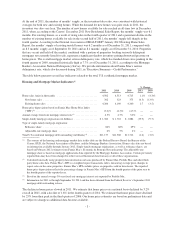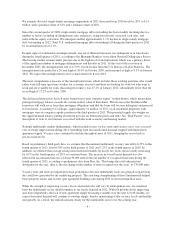Fannie Mae 2011 Annual Report Download - page 18
Download and view the complete annual report
Please find page 18 of the 2011 Fannie Mae annual report below. You can navigate through the pages in the report by either clicking on the pages listed below, or by using the keyword search tool below to find specific information within the annual report.-
 1
1 -
 2
2 -
 3
3 -
 4
4 -
 5
5 -
 6
6 -
 7
7 -
 8
8 -
 9
9 -
 10
10 -
 11
11 -
 12
12 -
 13
13 -
 14
14 -
 15
15 -
 16
16 -
 17
17 -
 18
18 -
 19
19 -
 20
20 -
 21
21 -
 22
22 -
 23
23 -
 24
24 -
 25
25 -
 26
26 -
 27
27 -
 28
28 -
 29
29 -
 30
30 -
 31
31 -
 32
32 -
 33
33 -
 34
34 -
 35
35 -
 36
36 -
 37
37 -
 38
38 -
 39
39 -
 40
40 -
 41
41 -
 42
42 -
 43
43 -
 44
44 -
 45
45 -
 46
46 -
 47
47 -
 48
48 -
 49
49 -
 50
50 -
 51
51 -
 52
52 -
 53
53 -
 54
54 -
 55
55 -
 56
56 -
 57
57 -
 58
58 -
 59
59 -
 60
60 -
 61
61 -
 62
62 -
 63
63 -
 64
64 -
 65
65 -
 66
66 -
 67
67 -
 68
68 -
 69
69 -
 70
70 -
 71
71 -
 72
72 -
 73
73 -
 74
74 -
 75
75 -
 76
76 -
 77
77 -
 78
78 -
 79
79 -
 80
80 -
 81
81 -
 82
82 -
 83
83 -
 84
84 -
 85
85 -
 86
86 -
 87
87 -
 88
88 -
 89
89 -
 90
90 -
 91
91 -
 92
92 -
 93
93 -
 94
94 -
 95
95 -
 96
96 -
 97
97 -
 98
98 -
 99
99 -
 100
100 -
 101
101 -
 102
102 -
 103
103 -
 104
104 -
 105
105 -
 106
106 -
 107
107 -
 108
108 -
 109
109 -
 110
110 -
 111
111 -
 112
112 -
 113
113 -
 114
114 -
 115
115 -
 116
116 -
 117
117 -
 118
118 -
 119
119 -
 120
120 -
 121
121 -
 122
122 -
 123
123 -
 124
124 -
 125
125 -
 126
126 -
 127
127 -
 128
128 -
 129
129 -
 130
130 -
 131
131 -
 132
132 -
 133
133 -
 134
134 -
 135
135 -
 136
136 -
 137
137 -
 138
138 -
 139
139 -
 140
140 -
 141
141 -
 142
142 -
 143
143 -
 144
144 -
 145
145 -
 146
146 -
 147
147 -
 148
148 -
 149
149 -
 150
150 -
 151
151 -
 152
152 -
 153
153 -
 154
154 -
 155
155 -
 156
156 -
 157
157 -
 158
158 -
 159
159 -
 160
160 -
 161
161 -
 162
162 -
 163
163 -
 164
164 -
 165
165 -
 166
166 -
 167
167 -
 168
168 -
 169
169 -
 170
170 -
 171
171 -
 172
172 -
 173
173 -
 174
174 -
 175
175 -
 176
176 -
 177
177 -
 178
178 -
 179
179 -
 180
180 -
 181
181 -
 182
182 -
 183
183 -
 184
184 -
 185
185 -
 186
186 -
 187
187 -
 188
188 -
 189
189 -
 190
190 -
 191
191 -
 192
192 -
 193
193 -
 194
194 -
 195
195 -
 196
196 -
 197
197 -
 198
198 -
 199
199 -
 200
200 -
 201
201 -
 202
202 -
 203
203 -
 204
204 -
 205
205 -
 206
206 -
 207
207 -
 208
208 -
 209
209 -
 210
210 -
 211
211 -
 212
212 -
 213
213 -
 214
214 -
 215
215 -
 216
216 -
 217
217 -
 218
218 -
 219
219 -
 220
220 -
 221
221 -
 222
222 -
 223
223 -
 224
224 -
 225
225 -
 226
226 -
 227
227 -
 228
228 -
 229
229 -
 230
230 -
 231
231 -
 232
232 -
 233
233 -
 234
234 -
 235
235 -
 236
236 -
 237
237 -
 238
238 -
 239
239 -
 240
240 -
 241
241 -
 242
242 -
 243
243 -
 244
244 -
 245
245 -
 246
246 -
 247
247 -
 248
248 -
 249
249 -
 250
250 -
 251
251 -
 252
252 -
 253
253 -
 254
254 -
 255
255 -
 256
256 -
 257
257 -
 258
258 -
 259
259 -
 260
260 -
 261
261 -
 262
262 -
 263
263 -
 264
264 -
 265
265 -
 266
266 -
 267
267 -
 268
268 -
 269
269 -
 270
270 -
 271
271 -
 272
272 -
 273
273 -
 274
274 -
 275
275 -
 276
276 -
 277
277 -
 278
278 -
 279
279 -
 280
280 -
 281
281 -
 282
282 -
 283
283 -
 284
284 -
 285
285 -
 286
286 -
 287
287 -
 288
288 -
 289
289 -
 290
290 -
 291
291 -
 292
292 -
 293
293 -
 294
294 -
 295
295 -
 296
296 -
 297
297 -
 298
298 -
 299
299 -
 300
300 -
 301
301 -
 302
302 -
 303
303 -
 304
304 -
 305
305 -
 306
306 -
 307
307 -
 308
308 -
 309
309 -
 310
310 -
 311
311 -
 312
312 -
 313
313 -
 314
314 -
 315
315 -
 316
316 -
 317
317 -
 318
318 -
 319
319 -
 320
320 -
 321
321 -
 322
322 -
 323
323 -
 324
324 -
 325
325 -
 326
326 -
 327
327 -
 328
328 -
 329
329 -
 330
330 -
 331
331 -
 332
332 -
 333
333 -
 334
334 -
 335
335 -
 336
336 -
 337
337 -
 338
338 -
 339
339 -
 340
340 -
 341
341 -
 342
342 -
 343
343 -
 344
344 -
 345
345 -
 346
346 -
 347
347 -
 348
348 -
 349
349 -
 350
350 -
 351
351 -
 352
352 -
 353
353 -
 354
354 -
 355
355 -
 356
356 -
 357
357 -
 358
358 -
 359
359 -
 360
360 -
 361
361 -
 362
362 -
 363
363 -
 364
364 -
 365
365 -
 366
366 -
 367
367 -
 368
368 -
 369
369 -
 370
370 -
 371
371 -
 372
372 -
 373
373 -
 374
374
 |
 |
characteristics of our loan acquisitions, in more detail in “MD&A—Risk Management—Credit Risk
Management—Single-Family Mortgage Credit Risk Management.”
Whether the loans we acquire in the future will exhibit an overall credit profile similar to our more recent
acquisitions will depend on a number of factors, including our future pricing and eligibility standards and those
of mortgage insurers and FHA, the percentage of loan originations representing refinancings, our future
objectives, government policy, market and competitive conditions, and the volume and characteristics of loans
we acquire under the recently announced changes to the terms of HARP.
Expected Losses on Our Legacy Book of Business
The single-family credit losses we realized in 2009 through 2011, combined with the amounts we have reserved
for single-family credit losses as of December 31, 2011, as described below, total approximately $140 billion. A
substantial majority of these losses are attributable to single-family loans we purchased or guaranteed from 2005
through 2008.
While loans we acquired in 2005 through 2008 will give rise to additional credit losses that we will realize when
the loans are charged off (upon foreclosure or our acceptance of a short sale or deed-in-lieu of foreclosure), we
estimate that we have reserved for the substantial majority of the remaining losses on these loans. Even though
we believe a substantial majority of the credit losses we have yet to realize on these loans has already been
reflected in our results of operations as credit-related expenses, our credit-related expenses have remained high as
weakness in the housing and mortgage markets continues. We expect that our credit-related expenses will
continue to be high in 2012 but that, overall, our credit-related expenses will be lower in 2012 than in 2011. The
amount of credit-related expenses we incur each period will be affected by changes in expected and actual home
prices, modifications and foreclosure activity during the period.
We expect our loss reserves will remain significantly elevated relative to historical levels for an extended period
because (1) we expect future defaults on loans in our legacy book of business and the resulting charge-offs will
occur over a period of years and (2) a significant portion of our reserves represents concessions granted to
borrowers upon modification of their loans and will remain in our reserves until the loans are fully repaid or
default. In addition, given the large existing and anticipated supply of single-family homes in the market, we
anticipate that it will take years before our REO inventory is reduced to pre-2008 levels.
We show how we calculate our realized credit losses in “Table 15: Credit Loss Performance Metrics.” Our
reserves for credit losses described in this discussion consist of (1) our allowance for loan losses, (2) our
allowance for accrued interest receivable, (3) our allowance for preforeclosure property taxes and insurance
receivables, and (4) our reserve for guaranty losses (collectively, our “total loss reserves”), plus the portion of
fair value losses on loans purchased out of unconsolidated MBS trusts reflected in our consolidated balance
sheets that we estimate represents accelerated credit losses we expect to realize. For more information on our
reserves for credit losses, see “Table 11: Total Loss Reserves.”
The fair value losses that we consider part of our reserves are not included in our “total loss reserves.” We
recorded the majority of these fair value losses prior to our adoption in 2010 of accounting guidance on the
transfers of financial assets and the consolidation of variable interest entities. Before we adopted this guidance,
upon our acquisition of credit-impaired loans out of unconsolidated MBS trusts, we recorded fair value loss
charge-offs against our reserve for guaranty losses. The amount of these charge-offs was the amount by which
the acquisition cost of these loans exceeded their estimated fair value. We expect to realize a portion of these fair
value losses as credit losses in the future (for loans that eventually involve foreclosures, short sales or
deeds-in-lieu of foreclosure), yet these fair value losses have already reduced the mortgage loan balances
reflected in our consolidated balance sheets and have effectively been recognized in our consolidated statements
of operations and comprehensive loss through our provision for guaranty losses. We consider these fair value
losses as an “effective reserve,” apart from our total loss reserves, to the extent that we expect to realize these
amounts as credit losses on the acquired loans in the future.
-13-
